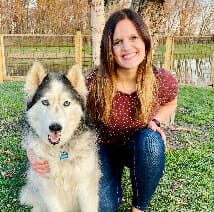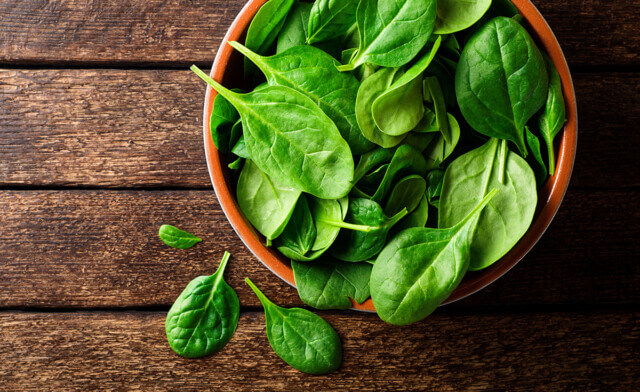Upset Stomach? Choosing the Best Food for a Dog with a Sensitive Stomach or Food Allergies
Finding the right food for your pets can be hard especially if your furry friend has a sensitive stomach. Let’s dive a little deeper and learn more about the causes, symptoms, and the different ways to help alleviate (and hopefully prevent) your pet’s stomach troubles, including how to find the best dog food for a dog with a sensitive stomach.
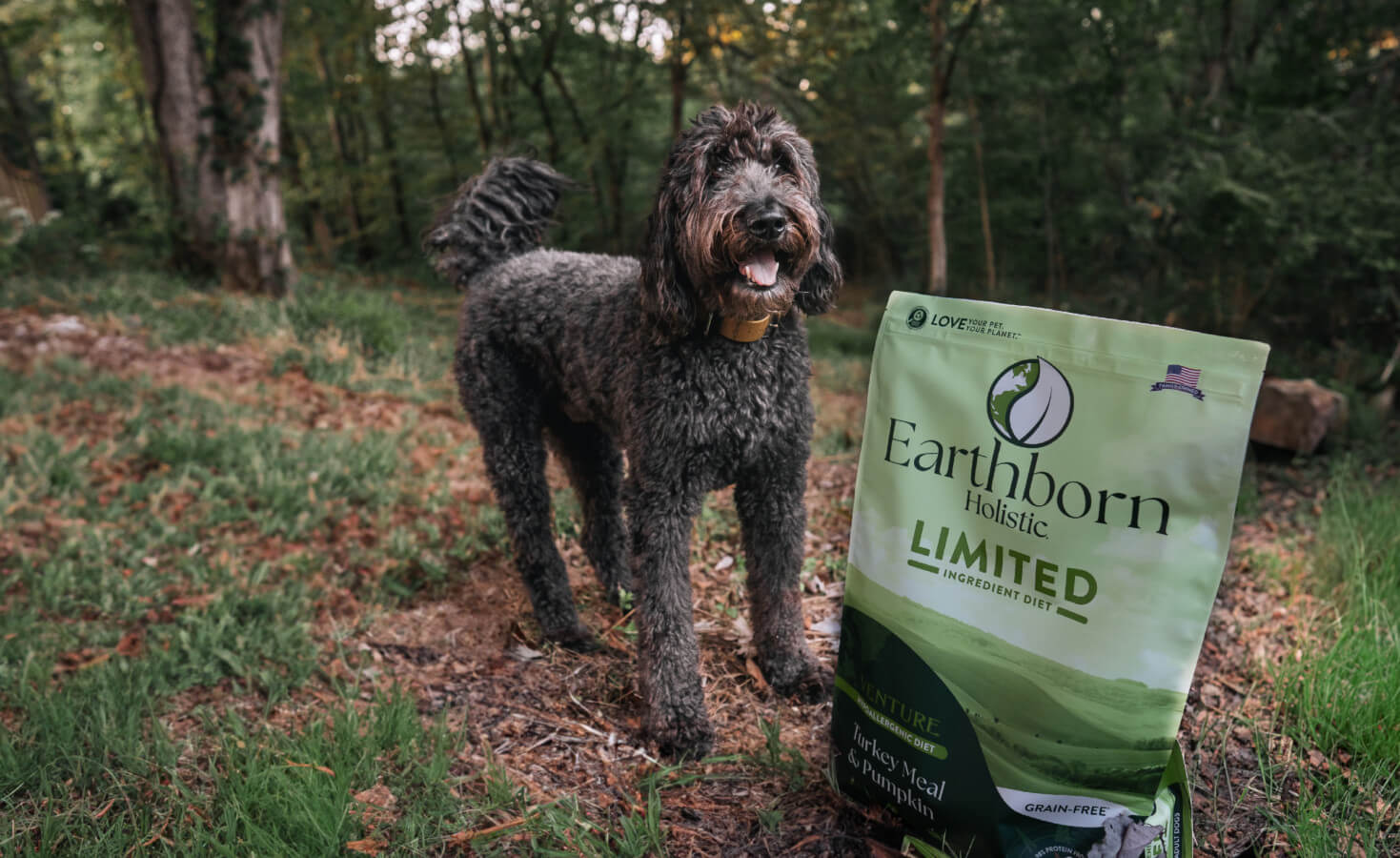
Causes of Upset Stomach in Dogs and Why Foods for Dogs with Sensitive Stomachs Are a Great Option
Just like with humans, there are many different reasons why your dog could be experiencing an upset stomach. Dog indigestion or dog upset stomach can occur when your furry friend is eating a new food or getting into plants, trash, or other household items that they are not supposed to.
However, if your dog tends to have an upset stomach often, it could be time to look into a food that helps the issue. Sensitive skin and stomach recipes are becoming increasingly popular and are great if your dog and their stomach just don’t seem to get along too great.
An upset stomach could also be a sign of a food intolerance, gastrointestinal infection, or an underlying health condition. With such a large variety of potential causes, it’s very important to identify the correct cause of your dog’s stomach issues in order to find the right solution. If you do find your dog has an upset stomach, some safe foods for dogs with upset stomach are pumpkin, shredded chicken, and chicken and rice. That being said, always make sure to check with your vet to rule out any underlying conditions.
Poisonous Plants for Dogs
Unfortunately, there are several plants that can be toxic to dogs if ingested. It’s a good idea to know what they are and have an idea of what they look like, too! Here are a few of the most toxic to watch out for:
- Castor bean
- Cyclamen
- Dumbcane
- Hemlock
- English Ivy
- Mistletoe
- Oleander
- Thorn apple
- Yew
- Any mushroom you cannot identify as safe!
For a complete list of plants to avoid please check out this Plants Toxic to Dogs list from the ASPCA.
Succulents are often a popular house or office plant choice, but are succulents poisonous to dogs? Well, some of them can be toxic like Aloe Vera, Kalanchoe, Euphorbia, and Jade plants and can cause dog upset stomach, diarrhea, and vomiting if ingested.
Some of the safer succulent options are Haworthia, Burro’s Tail, and Hens & Chickens, which tend to be the most popular and widely known succulent option. The good news is that there are still plenty of Plants Safe for Dogs to be around so if you are a plant lover know that you still have several options to green up your home or outdoors.
Foods Poisonous to Dogs
My dog likes to think with his stomach first which means we have to be extra careful with the foods we have in our household. According to the Humane Society, here are some of the foods that can cause stomach upset and be poisonous to your dog:
- Alcoholic Beverages
- Pits or seeds from apples, apricots, avocados, cherries, or peaches
- Chocolate
- Chives
- Coffee or tea
- Garlic
- Grapes or raisins
- Gum
- Macadamia nuts
- Potato or tomato leaves and stems (green parts)
- Onions, onion powder, and onion flakes
- Xylitol
- Yeast dough
If you suspect that your dog has ingested any of the foods above, contact your veterinarian immediately.
Changing Food Too Quickly
Another cause for an upset stomach can come when you transition your dog to a new diet too quickly. Switching your dog’s food cold turkey can cause stomach issues like vomiting and diarrhea–especially if your dog already has a sensitive stomach.
You may be wondering “how long will my dog have diarrhea after changing food?” If you switched food too quickly you may want to go back to your dog’s previous diet or withhold food for 12 – 24 hours to help clear up the vomiting and diarrhea.
During this time it’s extremely important to provide your dog with small amounts of water frequently to prevent dehydration. The diarrhea should resolve within 24 – 48 hours. If it doesn’t, be sure to contact your veterinarian.
Once your dog is feeling better you can start transitioning your dog’s diet again but at a slower pace. Utilizing a slow transition helps allow your dog’s system to adjust and produce the correct enzymes to properly digest the new food.
Eating Grass
Why do dogs eat grass when sick? It is believed that dogs eat grass to help soothe an upset stomach or increase their fiber intake. Some dogs also just eat grass because they like the taste. If you notice your dog’s interest in grass increases at certain times like with a change of diet then the grass eating may be tied to upset stomach relief.
Most of the time your dog eating grass is nothing to be concerned about. However, it’s always worth bringing up the behavior to your veterinarian to make sure there is no underlying condition or cause for concern.
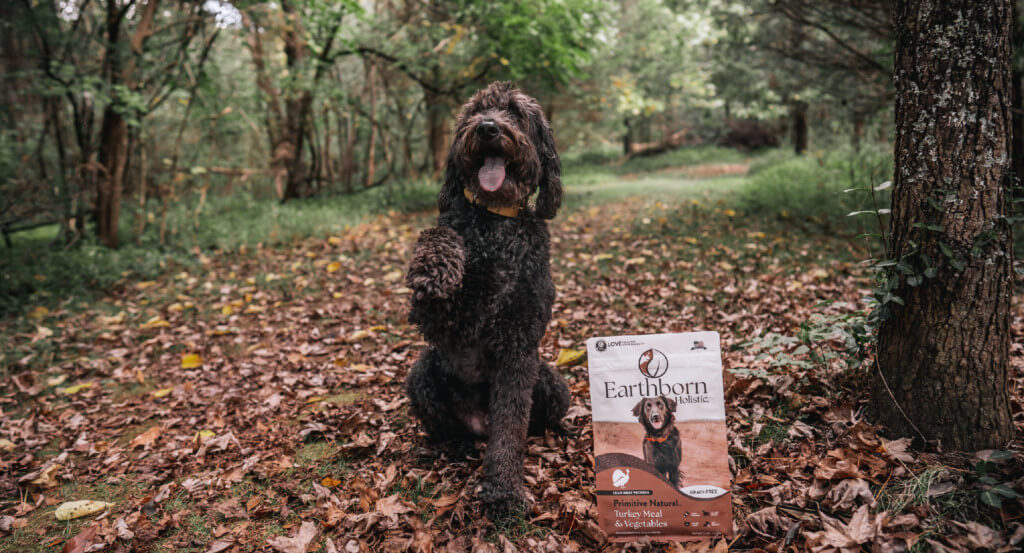
Signs Your Dog May Have an Upset Stomach or May Need to Start an Allergy Diet for Dogs
With your dog, upset stomach symptoms can range from diarrhea to a bloated stomach to even a disinterest in eating. Let’s learn more about these symptoms and what they could mean.
Diarrhea
When dealing with a dog’s upset stomach, diarrhea, or loose stools is normally the most common symptom to appear. According to the AKC, “The consistency and color of diarrhea reveal a lot about the cause of the problem and what is happening in your dog. Take very careful note of the color, consistency, and anything else that might help when you describe the symptoms to a vet.”
Gurgling
Also with your dog’s upset stomach, gurgling can be a first sign that your dog’s system is not liking something. Just like with humans, our stomachs can make noises for several reasons so gurgling is not always something to worry about. However, if it is accompanied by other symptoms or is out of the ordinary for your dog then it’s important to keep an eye on it.
Bloated Stomach
For a dog, a bloated stomach is a symptom that should be taken very seriously. Dog bloat can be dangerous and even deadly if not treated right away. Bloat can occur when a dog’s stomach fills up with gas, food, or a fluid which causes it to expand and put pressure on other nearby organs.
In some cases, the dog’s stomach can twist, trapping blood in the stomach and blocking the blood from returning to the heart and other areas of the body. This condition is called Gastric Dilatation Volvulus (GSV) and can send your dog into shock.
According to PetMD, the symptoms of GSV usually come on pretty quickly. Your dog may:
- Act restless
- Drool
- Have a swollen stomach
- Look anxious
- Look at their stomach
- Pace
- Try to vomit, but nothing comes up
- Stretch with their front half down and rear end up
As the condition gets worse, your dog may collapse, have pale gums, rapid heart rate, be short of breath, and/or feel weak. If your dog is experiencing these symptoms, contact your veterinarian or see an emergency vet as soon as possible.
Lethargy/Lack of Appetite
If your dog’s lethargic and not eating it could be a sign that your dog’s stomach is upset. However, lethargy could also be a symptom of many other conditions such as an injury, heatstroke, insect bite, ingestion of a toxic substance, or an underlying health condition.
Because lethargy is such a common symptom for many different ailments it’s important to pay attention to the degree of lethargy along with any other symptoms your dog is experiencing to help you or your vet determine the cause.
According to the Veterinary Emergency Group, “If you think your dog is more lethargic than he should be given his recent activity, you should take him to the vet for a complete checkup. And if he is lethargic along with other signs, you may want to consider taking him to the emergency vet instead.”
Common Breeds That May Benefit From Dog Food for Dogs with Sensitive Stomach Issues
Every dog breed is susceptible to tummy troubles every once in a while but there are a few breeds that may be a little more prone to ongoing issues.
For example, Irish Setters are genetically predisposed to GSE (Gluten-sensitive enteropathy) which causes stomach and skin issues when grains are ingested. For these dogs, feeding a specially formulated grain-free diet might be the best option for them.
Great Danes, St. Bernards, and Weimaraners are at a higher risk of having Gastric Dilatation-Volvulus (“bloat”) while Miniature Schnauzers and Yorkshire Terriers are more predisposed to pancreatitis.
So what is the best small breed dog food and best large breed dog food if your dog is predisposed to stomach issues? Unfortunately, the best dog food for dogs with sensitive stomachs will not be a one size fits all option. A lot of it will still depend on your dog’s individual needs to take into account any allergies or diet restrictions they may have. When choosing foods for dogs with skin allergies in these scenarios, it’s a decision best made with the help of your vet.
Limited ingredient diets, grain-free diets, or ancient grain diets with probiotics are usually great options to start with to help your dog’s sensitive stomach. Our Coastal Catch, Meadow Feast, and Ocean Fusion are three examples of recipes specially formulated for dogs with a sensitive stomachs and sensitive skin.
Dog Food for Sensitive Stomach Issues
You may be wondering what to feed a dog with an upset stomach. The answer can really vary depending on the reasons (food intolerance, allergy…etc.) why your dog has a sensitive stomach in the first place.
A limited ingredient dog food can do wonders on a sensitive stomach, but it’s not always necessary–sometimes all you need is a switch in protein to solve your problem. According to Dr. Anne, Earthborn Holistic’s Director of Nutrition Services, “since food allergies are (generally) in response to proteins from the diet that are misidentified by the immune system, switching the primary protein source in your dog’s diet can ease the allergy.
A high-quality sensitive skin and stomach dog food that includes a protein like turkey, lamb, salmon can be great options, as they are often easy to digest. Add in a healthy mix of fruits, veggies, and probiotics (for gut health) for a complete and balanced dog for dogs with sensitive stomachs that supports a healthy lifestyle.
If your dog has a sensitive stomach, one protein we always turn to is lamb. Dr. Anne Huss, explains that lamb tends to be a less commonly used animal protein in many diets, so the majority of our canine pals don’t have a chance to develop an allergy to it.
Finding wet dog food for sensitive stomach can be an alternative option to dry food. Our K95 Lamb and Lily’s Gourmet Buffet recipes are both lamb-based recipes that will be easier on their sensitive stomach. While these recipes aren’t specifically wet food for dogs with allergies, they can be a great option if your dog has an allergy to a protein other than lamb. Our tubs are even resealable, making them great travel options as well!
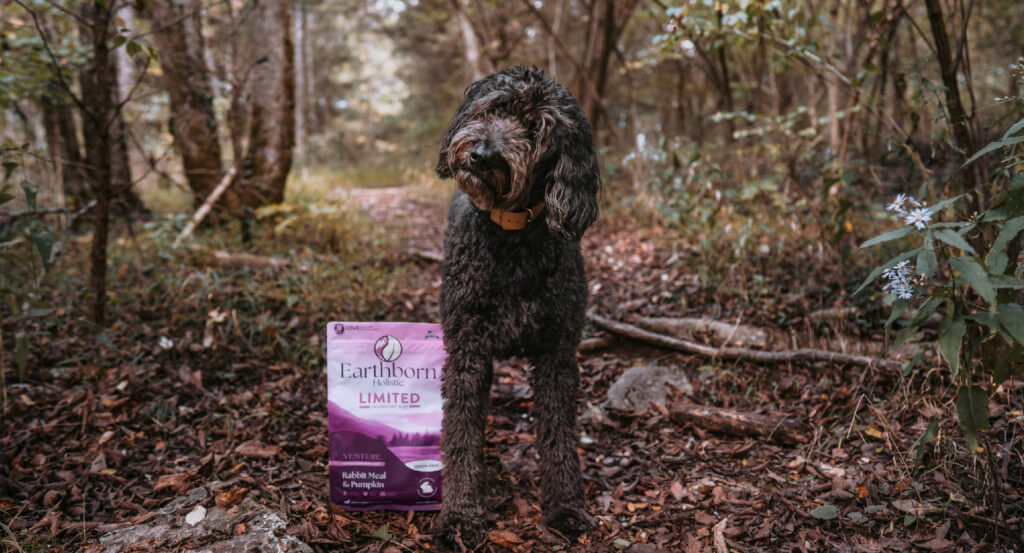
Dog Food for Dogs with Food Allergies
According to Dr. Anne, the most common dog allergies are to beef, dairy products, and wheat, and less common allergens include chicken, eggs, and soy. However, what happens when you don’t know what specific allergy is causing your dog’s symptoms?
Elimination Diet
If your dog is experiencing stomach issues and you think it could be because of their diet you may want to start implementing a dog elimination diet. Before doing this be sure to consult with your veterinarian to determine if this is the best path forward.
If you move forward with this method, your vet will most likely encourage you to feed one novel protein (a protein source that your dog hasn’t had before) and one carbohydrate for several weeks until all allergy symptoms have cleared.
Once that has happened, you will start adding in a new ingredient every few weeks. If itching or other allergy-like symptoms occur after the addition of the new ingredient then you know your dog has an intolerance or allergy to the new ingredient.
Testing out an elimination diet can be a very lengthy process, but can be worth it for many pet owners to ensure that their pup can eat and live itch-free without medications!
Hypoallergenic vs. Limited Ingredient Diets
Hypoallergenic dog food recipes are typically made with hydrolyzed proteins–often soy–that are made to bypass your dog’s natural immune response. If you know your dog’s specific allergy or dog food intolerance and can avoid it, a limited ingredient recipe is a great dog food for dogs with allergies to consider instead and can provide your dog with an animal protein source.
For a chicken allergy in dogs, our Limited Ingredient Diet dog food recipes are a great option as none of the products contain chicken. In fact, none of our Venture recipes contain any grain, gluten, chicken, egg, peas, lentils, colorants, fillers, by-products, or artificial preservatives.
Whole Grain Recipes
If your dog does not have a grain intolerance, then a whole grain recipe can be a great choice! Our Ancient Grains and Superfoods dog food recipes each start with a fresh protein source and are combined with carefully picked ancient grains and superfoods for a bowl of food that only has the good stuff. Whole grains can be great for sensitive stomachs since they can help aid with healthy digestion.
So what is the best food for dogs with allergies? Unfortunately, there’s no one recipe that’s perfect for every dog with an allergy. It’s a process that can sometimes take a little trial and error but our Limited Ingredient Diet dog food recipes can be a great place to start!
Switching to a New Dog Food for Dogs with Allergies
When you are switching dog food it’s important to transition gradually from the old food to the new food – especially if you have a dog with a sensitive stomach.
If you’re wondering how to change dog food we recommend that the transition period take between seven to ten days:
Days 1 & 2 – 25% new food, 75% old food
Days 3 & 4 – 50% new food, 50% old food
Days 5 & 6 – 75% new food, 25% old food
Day 7 – 100% new food
This gradual transition allows your pup’s system to better adjust to the new food and it helps decrease the chance of side effects like stomach upset.
If you’re changing dog food too quickly, symptoms can be vomiting, diarrhea, and a decreased appetite. These symptoms should resolve but if they persist longer than a couple of days contact your veterinarian.
Once you get through the transition phase and you’re ready to feed 100% of the new dog food it’s a good idea to utilize the feeding guidelines on the back of your pet food bag.
The feeding chart can be a great way to help ensure you are not overfeeding or under feeding your dog. However, it’s important to note that the feeding guidelines should serve as a starting point as portions will vary according to age, breed, temperament, and your pet’s environment.
Haven’t Tried a Good Dog Food for Allergies Yet? Here’s Some Tips for Cleaning Up Dog Messes
There are so many things to love about being a pet parent. Unfortunately, pet messes are probably not at the top of the list–especially if they are unexpectedly discovered by your foot. If you’ve yet to find a good dog food for allergies that works for your dog, you may be wondering how to clean up dog vomit and how to clean up dog diarrhea messes then grab your gloves, possibly some nose plugs, and read on.
Step one on how to clean dog vomit from carpet is to remove the excess vomit from the carpet first. You want to keep from pushing the vomit further into the carpet so try to find a piece of cardboard or similar material and scrape up the excess before treating the spot.
Once the excess has been removed, sprinkle cornstarch, baking soda, or kitty litter (if you are a cat parent) on the soiled area. These materials will help draw the stain out. Wait between 10-15 minutes and start vacuuming.
Next step is to treat the area! You can use an enzyme-based pet stain remover or a homemade mixture of warm water (2 cups), Dawn dish soap (1 tbsp), white vinegar (1 tbsp), and warm water (2 cups). A 50/50 mixture of hydrogen peroxide and water can also be used, too! However, if you decide to use hydrogen peroxide, dog vomit may not be your only issue because the hydrogen peroxide can sometimes cause discoloration on your carpet.
Blot or scrub the affected area until the stain has been removed. While still damp, sprinkle another round of baking soda to help absorb any lasting odors. Leave the baking soda on until it clumps and then vacuum up for the final time.
If there are any lingering odors try to air out the room or use a freshener spray.
If you are wondering how to clean dog vomit off a couch or other upholstery items please follow similar steps. You just may need to pay special attention if your couch is made of a unique fabric that requires different cleaning methods.
If you have a dog with a sensitive stomach you’re probably already a pro at dog poop clean-up. The process of how to get dog poop stains out of carpet is very similar to vomit so following the steps above is a good place to start.
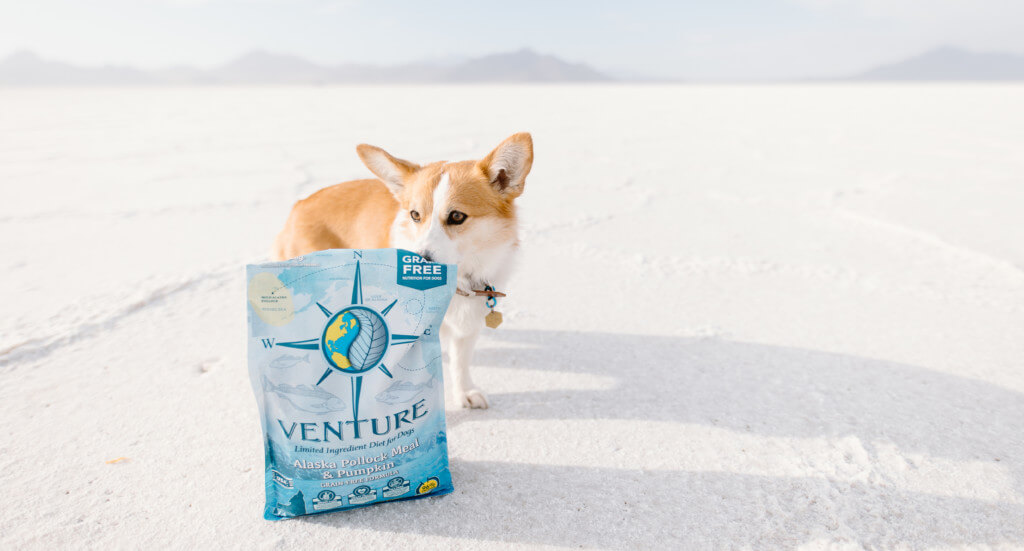
Health Risk for Dogs with Upset Stomachs
Upset stomachs are already a pain on their own, but there can also be additional health risks and digestive issues in dogs that can go along with them.
Dehydration
Here are some signs of dehydration in dogs to look out for:
- Loss of skin elasticity
- Loss of appetite
- Dry, sticky gums
- Vomiting with or without diarrhea
- Lethargy
- Panting
- Dry nose
- Sunken eyes
For your dog, dehydration treatment will vary depending on the severity of the symptoms.
According to AKC, “If you suspect your pet is dehydrated, first make sure he drinks plenty of fresh, cool water, especially in hot weather. In a vicious cycle, dehydrated dogs can lose their appetites, which causes them to eat less, and therefore eliminates the water content they would normally get from their food.”
A dehydrated dog’s gums may become sticky in the first stage of dehydration but if your dog’s gums become dryer and accompanied by other moderate to severe symptoms then you should take your dog to the vet immediately.
If your dog has an upset stomach often and you think something in their food or environment may be the cause, make sure to visit your vet to get to the bottom of it before any of these health risks become an issue. Your vet may suggest a food for dogs with upset stomach to help combat some symptoms if they believe the upset stomach is food-related.
Aside From Trying Foods for Dogs with Upset Stomach Issues, How Can You Help Your Dog Feel Better?
No one likes to see their furry friend feeling less than 100% so how can we make them feel better while dealing with an upset stomach? Let’s check out a few remedy options.
Fasting
Having your dog fast for 12 – 24 hours can be an effective treatment for an upset stomach especially if your dog’s body is working extra hard to get rid of something that’s in it. It’s important to consult with your veterinarian before fasting as not all dogs respond well to it.
Water/Ice
“Why is my dog drinking so much water?” is a common question. Dogs will drink more water if they are adjusting to a hotter temperature or will drink more water if their bodies are losing water through diarrhea or excessive panting. Your dog is trying to replace the fluids they’ve lost.
If your dog won’t eat but drinks water or if your dog’s not eating but drinking water and vomiting these could both be signs of an upset stomach or an infection.
Staying hydrated is extra important but sometimes it’s not the best feeling to fill up your stomach with lots of water after it’s been upset. So can dogs eat ice? Yes, chewing ice cubes can provide a great way to stay hydrated without getting too much water at one time.
What Else Can You Give Your Pup for an Upset Stomach?
Maybe your dog’s gut needs some help. Here are some foods you can give that may help their stomach.
Yogurt or Pumpkin
Pumpkin or yogurt can be another home remedy for easing an upset stomach.
Canned pumpkin (100% pumpkin, no additives) is a simple ingredient that is good for your dog’s digestion as the fiber adds bulk to their stool and reduces diarrhea.
What yogurt is good for dogs? Yogurt is non-toxic and contains probiotics which can be good for the digestive system. However, since it also contains lactose your dog’s body may not be able to digest it properly which may lead to further stomach problems. The best yogurt for dogs is plain, greek yogurt as this has a lower level of lactose. But be careful and look at the ingredient label to ensure there are no added sweeteners like xylitol or other ingredients that can be dangerous for your dog.
Probiotics
Feeding a dog food that contains probiotics is a great way to help maintain good digestive health for your dog. Venture recipes contain a mixture of probiotics for dogs with allergies. The limited amount of ingredients in each recipe plus the added probiotics for immune and gut health makes it a good option for dogs with allergies and sensitivities!
Check Out Earthborn’s Best Foods for Dogs with Allergies and Sensitive Stomachs!
If you’re looking for a recipe to calm your dog’s allergies or sensitive stomach, we’ve got plenty of options for you to try. If allergies are the culprit of your dog’s upset stomach, our Limited ingredient diets are a great choice. They’re made with fewer ingredients your dog is likely to be allergic to and more novel proteins like rabbit, duck, bison, and more. If stomach sensitivities are your main concerns, our Coastal Catch or Meadow Feast recipes are made with sensitive skin and stomach in mind. Check out our recipe pages to order your dog’s new favorite food today.
